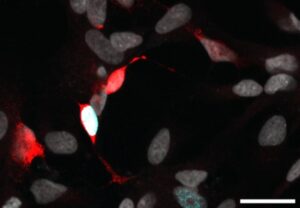In humans and other mammals, loss of neurons in the retina due to trauma or disease is an irreversible process that can lead to blindness. But unlike humans, some animals, such as fish, have the ability to spontaneously regenerate neurons in the retina by turning another retinal cell type, called Müller glia (MG), into neurogenic progenitors. Research headed by a team at the University of Washington has now shown how, in a lab setting, human Müller glia can also be coaxed into changing their identity, potentially offering up a new source of neurons for treating vision loss.
“Overall, our study provides a proof-of-principle that human glia can be reprogrammed to cells that are capable of making new neurons,” said research lead Thomas Reh, PhD. “This opens up an entirely new way to repair the retina in people that have lost neurons to disease or trauma. ” Reh, together with first author Juliette Wohlschlegel, PhD, and colleagues reported on their work in , in a paper titled, “ .
” Diseases that lead to degeneration of retinal cells are among the leading causes of blindness worldwide, the authors wrote. “Although regeneration of retinal cells is a robust process in some non-mammalian vertebrates, this process does not occur in mammals. ” Müller glia are supportive cells in the retina that help photoreceptors and other retinal neurons to function properly.
In some species, such as fish and birds, after injury, Müller glia can reprogram into immature retinal cells, and subsequently generate new retinal neurons. By contrast, Müller glia in the mammalian retina react to injury with scar formation and inflammation—a process known as gliosis—without making new neurons. This difference in behavior is based on different genetic programs being activated in fish versus mammalian Müller glia after injury.
“The molecular mechanisms involved in retinal regeneration have been well studied in fish, amphibians, and birds, and several key factors are critical for neural regeneration from MG,” the investigators further noted. One of these factors, a pro-neural transcription factor (TF) called Ascl1, is expressed after injury in fish and birds, but not in mammals. Interestingly, prior research has shown that artificial activation of the fish-like genetic program can turn mouse Müller glia into retinal neurons.
“When Ascl1 is overexpressed in mouse MG, the cells acquire a progenitor-like phenotype after injury, similar to that of the injured fish retina,” the investigators noted. “These MG-derived progenitor-like cells generate new neurons, which are functional and form connections with existing neurons. ” However, the team continued, up until now, it has not been known if the same strategy can be used to convert human Müller glia into neurons.
For their newly reported research, Reh and colleagues genetically modified human Müller glia in the lab to switch on neuron-specific genetic programs that would naturally happen in fish. They found that within a week, the genetically modified cells adopted neuron-like characteristics resembling those of immature retinal neurons. “Combining single-cell RNA sequencing, single-cell ATAC sequencing, immunofluorescence, and electrophysiology we demonstrate that human MG can be reprogrammed into neurogenic cells in vitro,” the team stated.
These findings suggest that human Müller glia can be coaxed into neurons and may serve as a resource to generate new neurons in patients’ retinas in the future. “Taken together, our work shows evidence of regenerative capacity in human MG,” the investigators stated. “This study constitutes a proof of principle that the human MG, as well as the mouse MG, can be reprogrammed into neurons after the overexpression of the pro-neural TF ASCL1.
” Of note, Müller glia in this study were derived from immature Müller glia and it remains to be seen if similar approaches can transform adult human Müller glia into neurons, and to what efficiency. “… while stimulation of regeneration may someday be a viable strategy to repair the human retina, many challenges remain,” Reh and colleagues noted. “We anticipate that future studies will continue to build on our findings, to explore the regenerative capacities of adult MG in degenerative contexts.
”.
From: genengnews
URL: https://www.genengnews.com/topics/translational-medicine/human-glia-reprogrammed-into-neuron-generating-cells/
